|
Rottweiler:
F.C.I.-Standard
Nr. 147 / 19.06.2000 / D
Origin:
Germany
Date of publication of the
valid original standard: 06.04.2000
Utilization:
Companion, service and working dog
Classifikation FCI: Group
2 (Pinscher and Schnauzer type, Molossian type and Swiss Mountain- and
Cattle Dogs and other breeds)
Section 2.1 Molossian type, Mastiff type with working trial.
·Brief
historical summary:
The Rottweiler is considered to be one of the oldest dog breeds. Its
origin goes back to Roman times. These dogs
were kept as herder or driving dogs. They marched over the
Alps
with the Roman legions, protecting the humans and driving their
cattle. In the region of Rottweil, these dogs met and mixed with the
native dogs in a natural crossing. The main task of the Rottweiler now
became the driving and guarding of the herds of cattle and the defense
of their masters and their property. This breed acquired its name from
the old free city of Rottweil and was known as the "Rottweil
butcher`s dog".
The
butchers bred this type of dog purely for performance and usefulness.
In due course, a first rate watch and driving dog evolved which could
also be used as a draught dog. When, at the beginning of the twentieth
century, various breeds were needed for police service, the Rottweiler
was amongst those tested. It soon became evident that the breed was
highly suitable for the tasks set by police service and therefore they
were officially recognized as police dogs in 1910.
Rottweiler
breeders aim at a dog of abundant strength, black coated with clearly
defined rich tan markings, whose powerful appearance does not lack
nobility and which is exceptionally well suited to being a companion,
service and working dog.
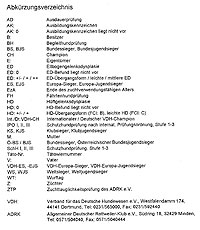 <
click on picture to view larger size
<
click on picture to view larger size
· General
Appearance:
The
Rottweiler is a medium to large size, stalwart dog, neither heavy nor
light and neither leggy nor weedy. His correctly proportioned, compact
and powerful build leads to the conclusion of great strength, agility
and endurance.
·
Important
Proportions:
The length of the body, measured from the sternum (breast-bone) to the
ischiatic tuberosity, should not exceed the height at the withers by,
at most,15%.
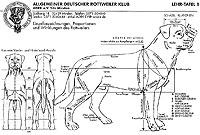 <
click on picture to view larger size
<
click on picture to view larger size
·
Behavior
/ Temperament:
Good natured,
placid in basic disposition and fond of children, very devoted,
obedient, biddable and eager to work. His appearance is natural and
rustic, his behaviour self assured, steady and fearless. He reacts to
his surroundings with great alertness.
·
Head:
Cranial
Region:
Skull:
Of medium length, broad between the ears. Forehead line moderately
arched as seen from the side. Occipital bone well developed without
being conspicuous.
Stop:
Well defined.
·
Facial Region:
Nose
well developed, more broad than round with relatively large nostrils,
always black.
Muzzle:
The foreface should appear neither elongated nor shortened in relation
to the cranial region. Straight nasal bridge, broad at base,
moderately tapered.
Lips:
Black, close fitting, corner of the mouth not visible, gum as dark as
possible.
Jaws
/ Teeth: Upper and lower jaw strong and broad. Strong complete
dentition (42 teeth) with scissor bite, the upper incisors closely
overlapping the lower incisors.
Cheeks:
Zygomatic arches pronounced.
Eyes:
Of medium size, almond shaped, dark brown in color. Eyelids close
fitting.
Ears:
Medium-sized, pendant, triangular, wide apart, set on high. With the
ears laid forward close to the head the skull appears to be broadened.
Neck: Strong, of fair length, well muscled, slightly arched, free from
throatiness, without dewlap.
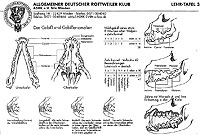 <
click on picture to view larger size
<
click on picture to view larger size
·
Body:
Straight,
strong, firm.
Loins: Short, strong and
deep.
Croup: Broad, of medium
length, slightly rounded. Neither flat nor falling away.
Chest: Roomy, broad and deep
(approximately 50 % of the shoulder height) with well developed fore
chest and well sprung ribs.
Belly: Flanks not tucked up.
Tail: In natural condition,
level in extension of the upper line; at ease may be hanging.
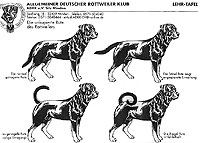 <
click on picture to view larger size
<
click on picture to view larger size
·
Limbs:
Forequarters:
Seen from the front, the front legs are straight and not placed too
closely to each other. The forearm, seen from the side, stands
straight. The slope of the shoulder blade is about 45 degrees to the
horizontal.
Shoulders: Well laid back.
Upper arm: Close fitting to the body.
Forearm: Strongly developed and muscular.
Pasterns: Slightly springy, strong, not steep.
Front feet: Round, tight and well arched; pads hard; nails short,
black and strong.
Hindquarters: Seen from behind, legs straight and not too close
together. When standing free, obtuse angles are formed between the
dog`s upper thigh and the hip bone, the upper thigh and the lower
thigh and the metatarsal.
Upper thigh: Moderately long, broad and strongly muscled.
Lower thigh: Long, strongly and broadly muscled at top, sinewy.
Hocks: Sturdy well angulated hocks; not steep.
Hind feet: Slightly longer than the front feet. Toes strong, arched,
as tight as front feet.
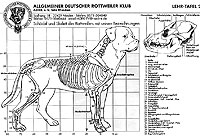 <
click on picture to view larger size
<
click on picture to view larger size
·
Gait:
The
Rottweiler is a trotting dog. In movement the back remains firm and
relatively stable. Movement harmonious, steady, full of energy and
unrestricted, with good stride.
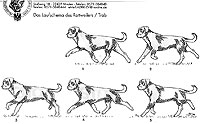 <
click on picture to view larger size
<
click on picture to view larger size
·
Skin:
Skin on the head: Overall tight fitting. When the
dog is alert, the forehead may be slightly wrinkled.
·
Coat:
Hair:
The coat consists of a top coat and an undercoat. The top coat is of
medium length, coarse, dense and flat. The undercoat must not show
through the top coat. The hair is a little longer on the hind legs.
Color: Black with clearly defined markings of a rich tan on the
cheeks, muzzle, throat, chest and legs, as well as over both eyes and
under the base of the tail.
·
Size and weight:
Weight at withers:
For males is 61 - 68 cm.(24-26.8 inches)
61 - 62 cm is small / 63 - 64 cm is medium height / 65 - 66 cm is
large - correct height / 67 - 68 cm is very large
Weight:
approximately 50 kg
Height
at withers:
For bitches is 56 - 63 cm.(22-24.8 inches)
56 - 57 cm is small / 58 - 59 cm is medium height / 60 - 61 cm is
large - correct height / 62 - 63 cm is very large
Weight: approximately 42 kg (92.6 pounds)
·
Faults:
Any departure from the foregoing points should be
considered a fault and the seriousness with which the fault should be
regarded should be in exact proportion to its degree.
General appearance: Light, weedy, leggy appearance. Light in bone and
muscle.
Head: Hound-type head. Narrow, light, too short, long or coarse head.
Flat forehead (lack of stop or too little stop).
Foreface: Long or pointed muzzle; split nose; Roman nose (convex nasal
bridge) or dish-faced (concave nasal bridge); aquiline nose; pale or
spotted nose (butterfly nose).
Lips: Pendulous, pink or patchy; corner of lips visible.
Jaws: Narrow lower jaw.
Bite: Pincer bite.
Cheeks: Strongly protruding.
Eyes: Light, deep set. Also too full and round eyes; loose eye-lids.
Ears: Set on too low, heavy, long, slack or turned backwards. Also
flying ears or ears not carried symmetrically.
Neck: Too long, thin, lacking muscle. Showing dewlap or throaty.
Body: Too long, too short or too narrow.
Back: Too long, weak; sway-back or roach back.
Croup: Too sloping, too short, too flat or too long.
Chest: Flat ribbed or barrel shaped. Too narrow behind.
Tail: Set on too high or too low.
Forequarters: Narrow or crooked front legs. Steep shoulder placement.
Loose or out at elbow. Too long, too short or too straight in upper
arm. Weak or steep pastern. Splayed feet. Too flat or too arched toes.
Deformed toes. Light colored nails.
Hindquarters: Flat thighs, hocks too close, cow hocks or barrel hocks.
Joints with too little or too much angulation. Dewclaws.
Skin: Wrinkles on head
Coat: Soft, too short or too long. Wavy coat; lack of undercoat.
Color: Markings of incorrect color, not clearly defined.. Markings
which are too spread out.
·
Eliminating
Faults:
General: Distinct reversal of sexual type, i.e. feminine dogs or
masculine bitches.
Teeth: Overshot or undershot bite, wry mouth; lack of one incisive
tooth, one canine, one premolar and one molar.
Eyes: Entropion, ectropion, yellow eyes, different colored eyes.
Tail: Kink tail, ring tail, with strong lateral deviation
Hair: Definitely long or wavy coat.
Color: Dogs which do not show the typical Rottweiler coloring of black
with tan markings. White markings.
Behavior: Anxious, shy, cowardly, gun-shy, vicious, excessively
suspicious, nervous animals.
N.B.: Male animals must have two apparently normal testicles fully
descended into the scrotum.
back to
top
|





